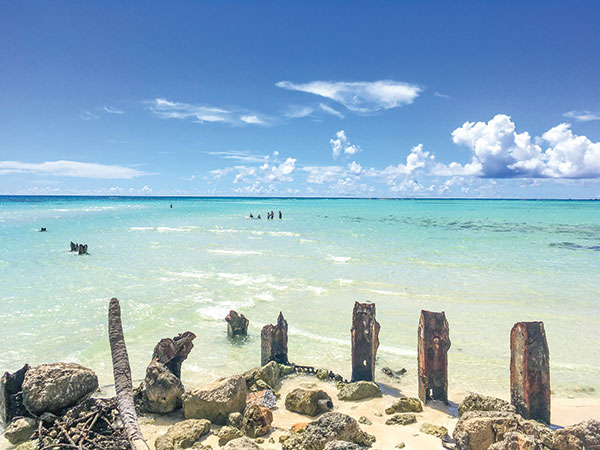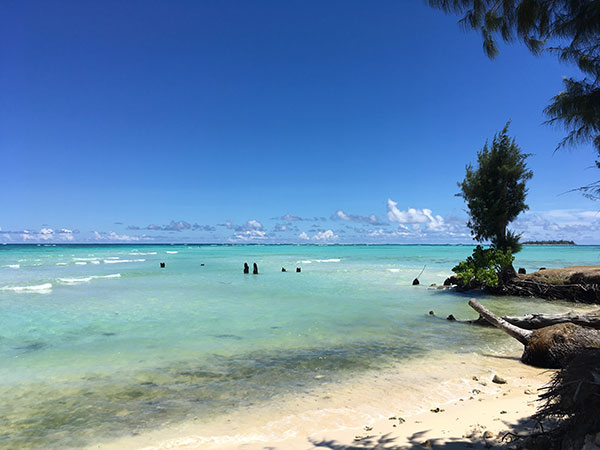Is Saipan shrinking?

Rising sea levels will affect sandy beaches along lagoons. Low-lying areas such as Garapan and Susupe will be periodically submerged during extreme tides or storm events in the coming decades. (IVA MAURIN)
Today’s flood is tomorrow’s high tide.
These past months, storms have seen the CNMI experiencing more and more flooding, which got people wondering whether Saipan will eventually shrink and get submerged in water.
The straight answer is no…and yes.
In terms of its physical land mass, the island will not shrink. However, in the coming decades, Saipan’s functional space would. Some low-lying areas, such as Garapan and Susupe, will be periodically submerged during extreme tides or storm events.
“The island will still have 44 square miles of land in 2050, but not all of that land may be as functional or valuable as it is today,” said Robbie Greene, coastal management specialist with the National Oceanic and Atmospheric Administration.
Greene explained that in assessing sea level rise impacts, areas that may be underwater in 80 years are not the sole focus.
“We are also looking at parts of our community that might not function because coastal flooding will become more and more of a nuisance,” Greene said. “Most of [the] CNMI’s infrastructure is concentrated on Saipan’s low-lying western coastal plain, which may be challenged by recurrent, temporary flooding in the next 20 years.”
Greene, who, as the NOAA liaison for the Division of Coastal Resources Management, points out that the CUC power plant in Lower Base is a perfect example. While the power plant has not been affected by coastal floods, roads leading to it will likely get submerged in the future.
“The power plant itself is not threatened by sea level rise, and hasn’t really been impacted by coastal flooding,” Greene said. “However, some of the access roads and nearby infrastructure within a quarter mile of the power plant will likely see coastal flood hazards in the coming decades.”
In this sense, while the land area remains the same, the functionality of much of the infrastructure in Lower Base may “shrink.”
This also applies to shorelines, including sandy beaches along the Tanapag Lagoon. Some areas around the American Memorial Park and Puerto Rico will also likely experience flooding at high tide in the next 30 years.
Fortunately, the CNMI has a substantial amount of time to begin adapting so that new investments and restoration/revival of outdated infrastructure are not as susceptible to future sea level change, Greene said.
Plenty of government agencies and offices in CNMI, in fact, have participated in climate adaptation working groups and trainings over the years, with several agencies even having produced guidance for the CNMI as to how it can continue to grow and develop while building resiliency and adapting to sea level rise.
These guidelines simply need to be implemented and followed.
Greene also recommends a thorough review and potential enhancements to certain projects and plans that are getting underway, such as how the stormwater infrastructure can be revamped to function with sea level rise, and thinking critically about how to invest in a feature like Beach Road.
Current government programs include the implementation of the Garapan Revitalization Plan. Earlier this year, the Office of Planning and Development, Zoning Office, and the Garapan Revitalization Task Force hosted a stakeholder meeting to talk about revitalizing Saipan’s commercial district.
“Responding to climate change and climate extremes requires making smart, forward-thinking decisions. Often these are not ‘new’ policies or plans, but rather the things we should have been doing all along,” Greene said.
For individuals interested in visualizing impacts of flood hazards to Saipan, check NOAA’s Coastal Flood Exposure Mapper at http://bit.ly/2pQyICF.

Rising sea levels will affect sandy beaches along lagoons. Low-lying areas such as Garapan and Susupe will be periodically submerged during extreme tides or storm events in the coming decades. (IVA MAURIN)























